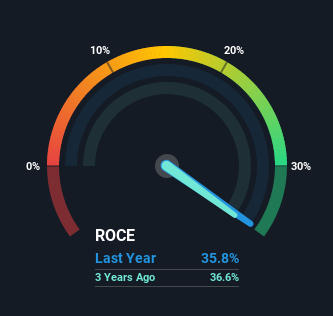A Look Into Knaus Tabbert's (ETR:KTA) Impressive Returns On Capital

What are the early trends we should look for to identify a stock that could multiply in value over the long term? Amongst other things, we'll want to see two things; firstly, a growing return on capital employed (ROCE) and secondly, an expansion in the company's amount of capital employed. Basically this means that a company has profitable initiatives that it can continue to reinvest in, which is a trait of a compounding machine. So, when we ran our eye over Knaus Tabbert's (ETR:KTA) trend of ROCE, we really liked what we saw.
Understanding Return On Capital Employed (ROCE)
If you haven't worked with ROCE before, it measures the 'return' (pre-tax profit) a company generates from capital employed in its business. The formula for this calculation on Knaus Tabbert is:
Return on Capital Employed = Earnings Before Interest and Tax (EBIT) ÷ (Total Assets - Current Liabilities)
0.36 = €59m ÷ (€334m - €169m) (Based on the trailing twelve months to June 2021).
So, Knaus Tabbert has an ROCE of 36%. That's a fantastic return and not only that, it outpaces the average of 8.2% earned by companies in a similar industry.
View our latest analysis for Knaus Tabbert

In the above chart we have measured Knaus Tabbert's prior ROCE against its prior performance, but the future is arguably more important. If you'd like, you can check out the forecasts from the analysts covering Knaus Tabbert here for free.
The Trend Of ROCE
Knaus Tabbert deserves to be commended in regards to it's returns. Over the past three years, ROCE has remained relatively flat at around 36% and the business has deployed 43% more capital into its operations. With returns that high, it's great that the business can continually reinvest its money at such appealing rates of return. If these trends can continue, it wouldn't surprise us if the company became a multi-bagger.
Another thing to note, Knaus Tabbert has a high ratio of current liabilities to total assets of 50%. This can bring about some risks because the company is basically operating with a rather large reliance on its suppliers or other sorts of short-term creditors. While it's not necessarily a bad thing, it can be beneficial if this ratio is lower.
In Conclusion...
In summary, we're delighted to see that Knaus Tabbert has been compounding returns by reinvesting at consistently high rates of return, as these are common traits of a multi-bagger. However, over the last year, the stock has only delivered a 2.5% return to shareholders who held over that period. That's why it could be worth your time looking into this stock further to discover if it has more traits of a multi-bagger.
One more thing, we've spotted 1 warning sign facing Knaus Tabbert that you might find interesting.
If you'd like to see other companies earning high returns, check out our free list of companies earning high returns with solid balance sheets here.
Valuation is complex, but we're here to simplify it.
Discover if Knaus Tabbert might be undervalued or overvalued with our detailed analysis, featuring fair value estimates, potential risks, dividends, insider trades, and its financial condition.
Access Free AnalysisThis article by Simply Wall St is general in nature. We provide commentary based on historical data and analyst forecasts only using an unbiased methodology and our articles are not intended to be financial advice. It does not constitute a recommendation to buy or sell any stock, and does not take account of your objectives, or your financial situation. We aim to bring you long-term focused analysis driven by fundamental data. Note that our analysis may not factor in the latest price-sensitive company announcements or qualitative material. Simply Wall St has no position in any stocks mentioned.
Have feedback on this article? Concerned about the content? Get in touch with us directly. Alternatively, email editorial-team (at) simplywallst.com.
About XTRA:KTA
Knaus Tabbert
Manufactures and sells recreational vehicles in Germany, Europe.
Undervalued with moderate growth potential.
Similar Companies
Market Insights
Community Narratives




